We are back! After far to long an absence!
It’s been a busy couple of week for marine life enthusiasts in the
North West, the North West conference, the upcoming Irish Sea conference
in Liverpool Maritime Museum, the Manchester Science Festival and of
course Blackpool & Fylde’s first ever ‘Marine Day’.
Sponsored by the Biology society, this event was a great opportunity
for students to get in contact with ‘real’ people working in marine
science. With displays from the RSPB and local Wildlife Trusts as well
as workshops on wildlife photography, coral conservation and of course,
UK cetacean identification and Matt was also here talking about UK shark species as well as workshops and a talk from Dr. Dan Exton from Operation Wallacea, it was an
exciting event not only for the students but also the exhibitors
themselves!
 |
| Themed cupcakes for Marine Day! |
Having already given a talk on Sea Watch and UK cetaceans at
Blackpool earlier this year, there were a couple of familiar faces in
the workshop- and they had clearly done their homework on cetacean ID
and were keen to be tested! With over 25 species of cetaceans having
been sighted in the UK in the past 20 years, it would have taken a lot
longer than a 15 minute workshop to cover all eventualities so the focus
was on identifying the most commonly seen species such as bottlenose
dolphins, harbour porpoise and minke whales based on the often fleeting
cues that you spot at sea. If you are looking for a detailed species
profile, check out my
previous blog article or the
Sea Watch identification guides.
 |
| Cetacean ID workshop |
The first thing to note when encountering a cetacean at sea is size;
estimating size at sea is tricky as you may only get a quick glance, if
you can it is a good idea to compare it’s size to the vessel you are on
as it will give you a rough estimate of the size.
Note the size, shape and positioning of the dorsal fin; in baleen
whales the dorsal fin is usually about 2/3 of the way down the animal’s
back whereas in dolphins it tends to be more centrally placed. Some
whales have small falcate fins that are not dissimilar from a typical
curved dolphin fin, so watch out how much back you see before the fin
appears. Some species have very characteristic fins, as for example
killer whales, where the dorsal of the male can reach up to 2m in height
and is extremely straight and erect. Others, such as pilot whales, have
a large, broad based curved fin that differentiates them from most
other species. Porpoises, in comparison to dolphins have small
triangular fins.
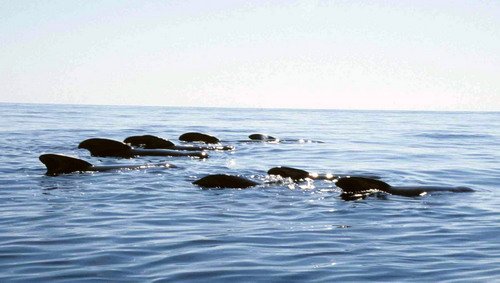 |
| Long finned pilot whales |
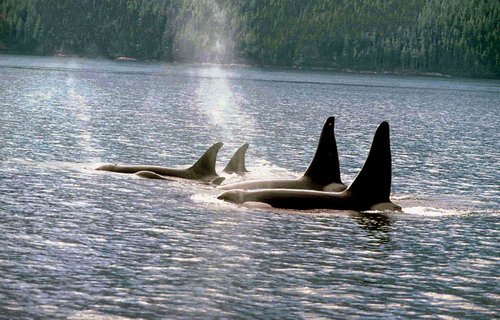 |
| Killer whale dorsal fins, note the tall straight ones belong to the males, the shorter curved ones females or immature males |
Try to get an idea of the animals colouration, although colours can
be misleading depending on what light you see the animals in, some
species have highly characteristic colouration such as the easily
identifiable black & white colouring in killer whales, other species
such as common dolphins have prominent hourglass shading on their
sides.
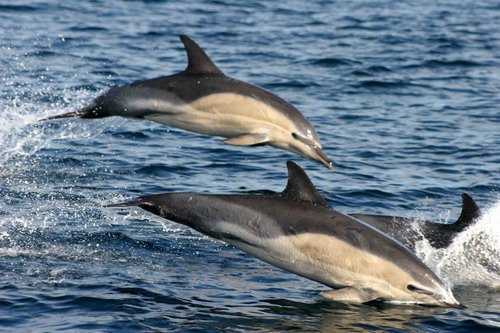 |
| Short beaked common dolphin |
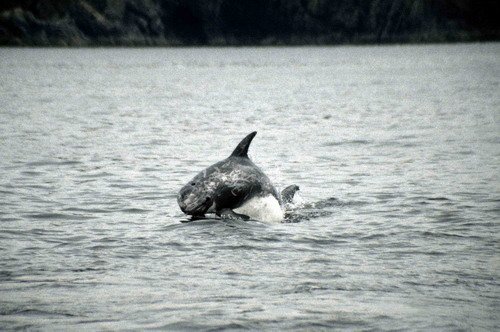 |
| Risso's dolphin, note absence of beak |
You are not guaranteed to see the animals head but if you do, make a
note of it’s shape; does it have a prominent beak, is it rounded, does
it have a large melon (‘forehead)?
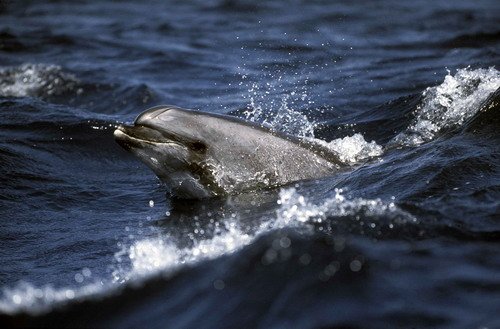 |
| Bottlenose dolphin, note prominent beak |
Finally, although not quite as useful for identification as physical
attributes, observe the animal’s behaviour. Although it is by no means a
fail safe method, some species are more likely to behave in certain
ways than others; for instance harbour porpoises rarely leap out of the
water, so if you are looking at small bodied, leaping cetaceans, it’s
unlikely they are porpoises.
Generally it is a good idea to make notes on anything and everything
you see, write it down if possible, at the time it may seem like you
will never forget a detail of the encounter but you would be surprised
how the mind can play tricks on you!
 |
| Me starting my talk! |
|
After Kat had finished her workshops it was my turn to take to the stage with my first ever talk. Over the summer I ran a series of shark tagging trip in Mersey bay looking to tag tope and common and starry smoothhounds (we will have an article on this soon). Jean Wilson (Blackpool and Fylde colleges head of biology) attended on of these trips and as well as catching two sharks (and tagging one) she invited me to give a talk on Marine Day on UK shark species.
I must admit, writing my first talk was a little bit nerve racking! But as I got in front of the audience and began the talk I found it very exciting. The talk was a small overview of shark basic shark biology and information on a selection of UK shark species. My aim was to introduce the students and staff the range of shark species in UK waters, of which there are more than many people expect.
I had a lot of fun showing people the smooth hammerhead, the second largest of the hammerheads, the porbeagle and mako sharks, smaller relatives of the great white and the largest of the dogfish, the greenland shark and the shark no one in the room had previously heard of, the frilled shark.
 |
| A smooth hammerhead |
The talk also gave me the opportunity to advertise my shark tagging trips in the north west of England (which are not for profit) where we arrange for the public to have the opportunity to fish for and tag local shark species.
 |
| Frilled shark |
The talk was a great success and I hope to be able to offer more in the future, not just on sharks but also on biotelemetry.
We would like to thank Blackpool and Fylde College and to Jean Wilson for making this possible!
I would also like to add, for anyone thinking of a blog site, I cannot reccomend you don't use the awfulness of Blogger!











Good luck with the new blog!
ReplyDeleteReally like the new Blog, If you or any of your readers are interested in issues involving navy sonar and marine mammals check out http://deafeningsoundoffreedom.wordpress.com/
ReplyDelete